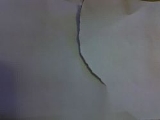
Tearing
Encyclopedia

Cutting tool
In the context of machining, a cutting tool is any tool that is used to remove material from the workpiece by means of shear deformation. Cutting may be accomplished by single-point or multipoint tools. Single-point tools are used in turning, shaping, plaining and similar operations, and remove...
. A tear
Tear
Tear may refer to:*Tears, a type of eye secretion*Tearing, the ripping apart of something by force*Robert Tear, a Welsh singer-Elements in fiction:*Tear, a character Tear Grants in video game Tales of the Abyss...
in a piece of paper
Paper
Paper is a thin material mainly used for writing upon, printing upon, drawing or for packaging. It is produced by pressing together moist fibers, typically cellulose pulp derived from wood, rags or grasses, and drying them into flexible sheets....
, fabric
Fabric
A fabric is a textile material, short for "textile fabric".Fabric may also refer to:*Fabric , the spatial and geometric configuration of elements within a rock*Fabric , a nightclub in London, England...
, or some other similar object may be the result of the intentional effort with one's bare hands, or be accidental. Unlike a cut
Cutting
Cutting is the separation of a physical object, or a portion of a physical object, into two portions, through the application of an acutely directed force. An implement commonly used for cutting is the knife or in medical cases the scalpel...
, which is generally on a straight or patterned line controlled by a tool such as scissors
Scissors
Scissors are hand-operated cutting instruments. They consist of a pair of metal blades pivoted so that the sharpened edges slide against each other when the handles opposite to the pivot are closed. Scissors are used for cutting various thin materials, such as paper, cardboard, metal foil, thin...
, a tear is generally uneven and, for the most part, unplanned. An exception is a tear along a perforated line
Perforation
A perforation is a small hole in a thin material or web. There is usually more than one perforation in an organized fashion, where all of the holes are called a perforation...
, as found on a roll of toilet paper
Toilet paper
Toilet paper is a soft paper product used to maintain personal hygiene after human defecation or urination. However, it can also be used for other purposes such as blowing one's nose when one has a cold or absorbing common spills around the house, although paper towels are more used for the latter...
or paper towel
Paper towel
A paper towel is an absorbent textile made from paper instead of cloth. Unlike cloth towels, paper towels are disposable and intended to be used only once. Paper towels soak up water because they are loosely woven which enables water to travel between them, even against gravity...
s, which has been previously partially cut, so the effort of tearing will probably produce a straight line.
Materials vary in their susceptibility to tearing. Some materials may be quite resistant to tearing when they are in their full form, but when a small cut or tear is made, the material becomes compromised, and the effort needed to continue tearing along that line becomes less.
Materials can be characterized by standard methods to measure their 'tear strength'. There are several applicable standards which vary around the world. The variables which affect the tear strength can be summarized neatly by the quote:
"The value of tear strength obtained depends on the shape of the test piece, speed of stretching and
temperature of test."

